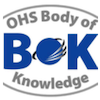Chapter 15: Hazard as a Concept
Abstract
In occupational health and safety (OHS), the term ‘hazard’ is defined and used in many different ways. In introducing a series of hazard-specific chapters in the OHS Body of Knowledge, this chapter considers some of the issues associated with these various definitions and applications, including, for example, the common misidentification of failures of controls as hazards and equating hazard with risk. This chapter discusses a range of definitions and classification systems for hazards and proposes that while different definitions and classification systems may be useful depending on the context of the OHS activity; extended discussion on the topic is advocated. This discussion needs to acknowledge that multiple hazards may be present in many situations, and that workplaces are inherently complex systems. While different definitions and classifications of hazards may be tailored to different contexts and purposes, the chapter concludes that there is a need to reconceptualise our understanding of what constitutes a hazard to address the complexity of causation of some workplace injuries and conditions.
Keywords: hazard, hazardous, risk, energy, complex systems
First year of publication: 2012
Current Version: 2024
Chapter 15: Hazard as a concept
Table of contents
| 1 | Introduction |
| 2 | ‘Hazard’ definitional issues |
| 2.1 | Scope of definitions |
| 2.2 | Confusion with ‘failures in control’ |
| 2.3 | Confusion with ‘risk’ |
| 3 | Hazard as a ‘source of potentially damaging energy’ |
| 3.1 | Limitations of the energy-damage conception of hazard |
| 4 | Classifications of hazards |
| 4.1 | A common classification |
| 4.2 | Energy-based hazard classification |
| 4.3 | Contextual classification of hazards |
| 4.4 | Psychosocial hazards |
| 5 | Implications for practice |
| 6 | Summary |
| References |

Pam Pryor AO, BSc, BEd, GDipOHM, MAppSci, ChOHSP, FAIHS
Past -Manager OHS Body of Knowledge Development, Australian Institute of Health and Safety
With a background in OHS consulting and OHS education Pam now specialises in activities around OHS capability and related aspects of OHS professionality. She was chair of the Technical Panel that developed the OHS Body of Knowledge and inaugural Registrar of the Australian OHS Education Accreditation Board. Her current role as Manager OHS Body of Knowledge Development focuses on the ongoing maintenance and development of the OHS Body of Knowledge and associated resources. Pam was a key player in the development of the INSHPO Global OHS Capability Framework and received the 2017-18 President’s Award from American Society of Safety Professionals (ASSP) for this work. Pam received an Officer of the Order of Australia in 2018 for her contribution to OHS through leadership and advisory roles, particularly in developing standards for education frameworks.
No learning outcomes have been developed for the chapters considered introductory or underpinning knowledge (that is chapters 2, 3, 4, 5, 6, 7, 8, 14, 15.)
Published 2012 Chapter 15 Hazards as a Concept
Published 2019 Chapter 15 Hazard as a Concept 2019

